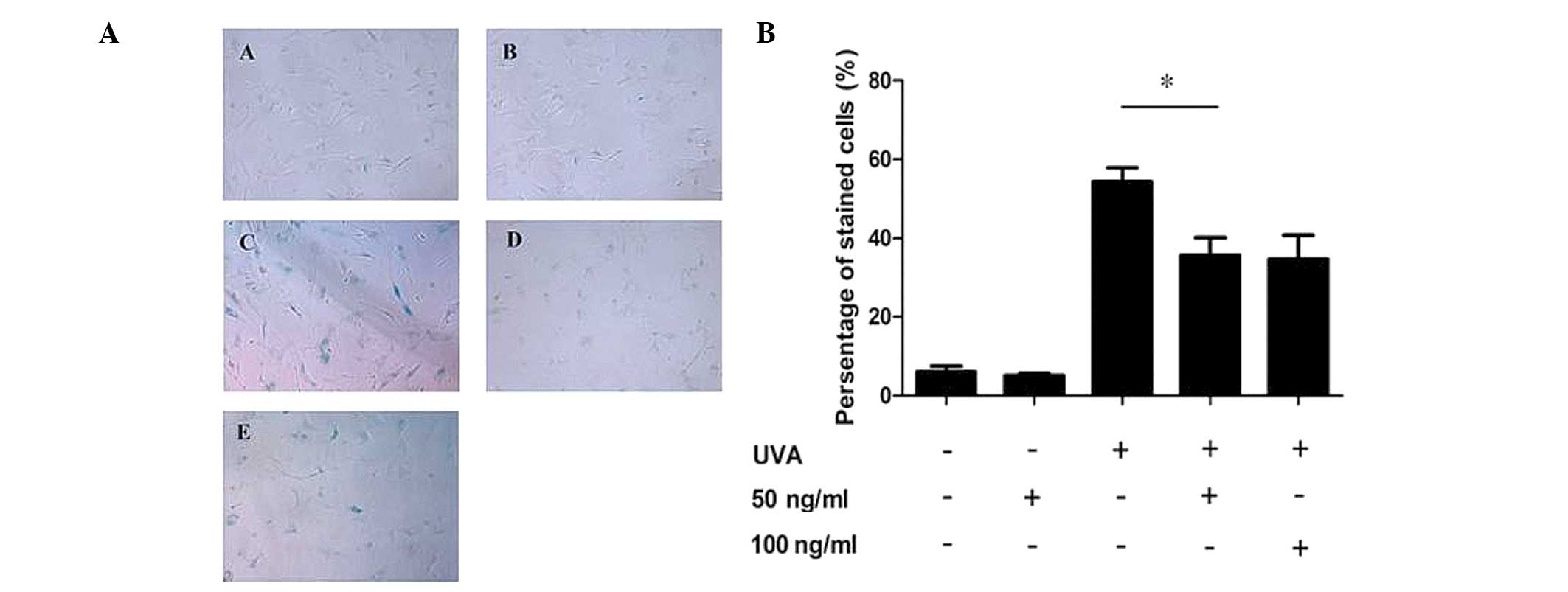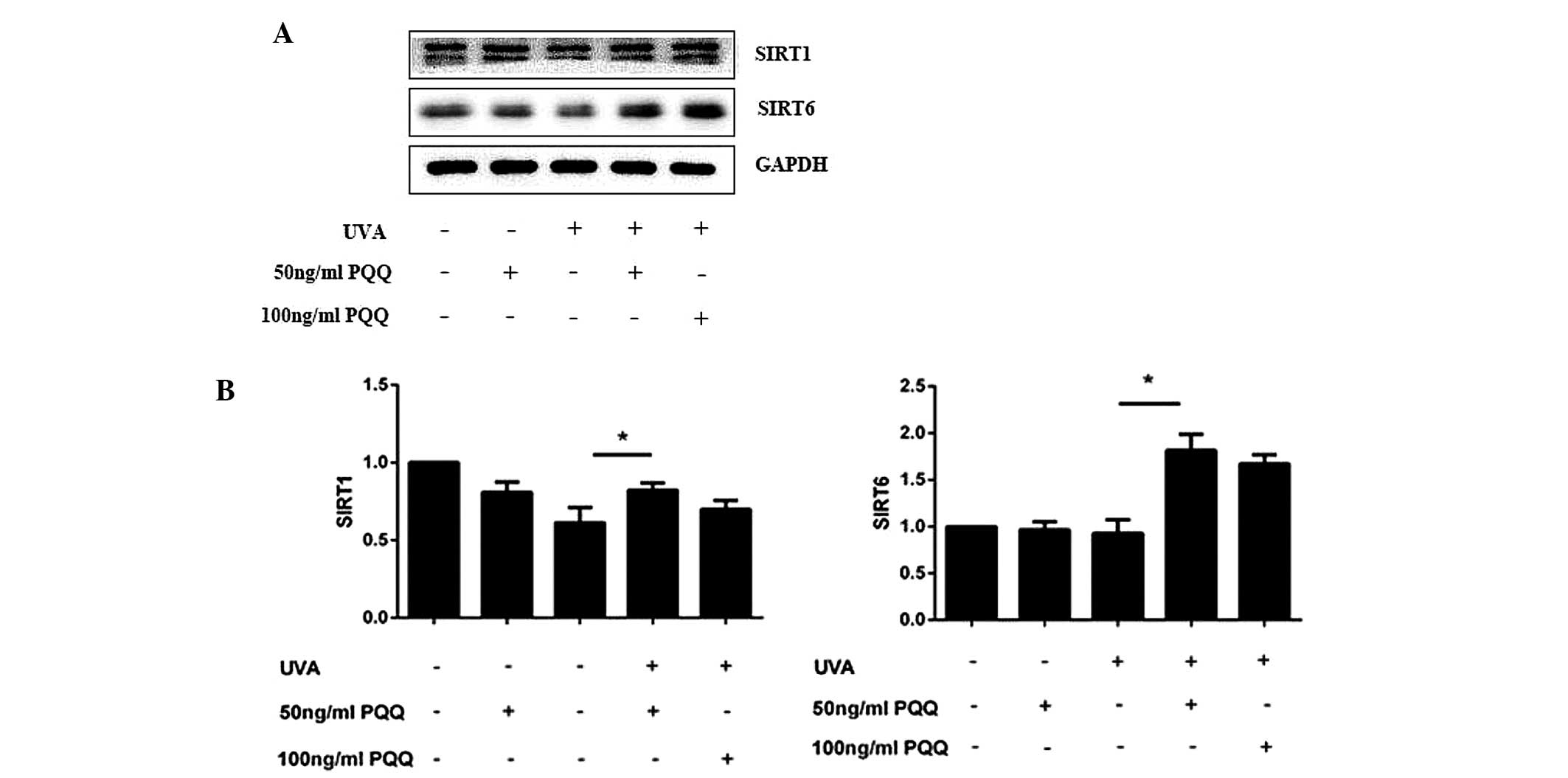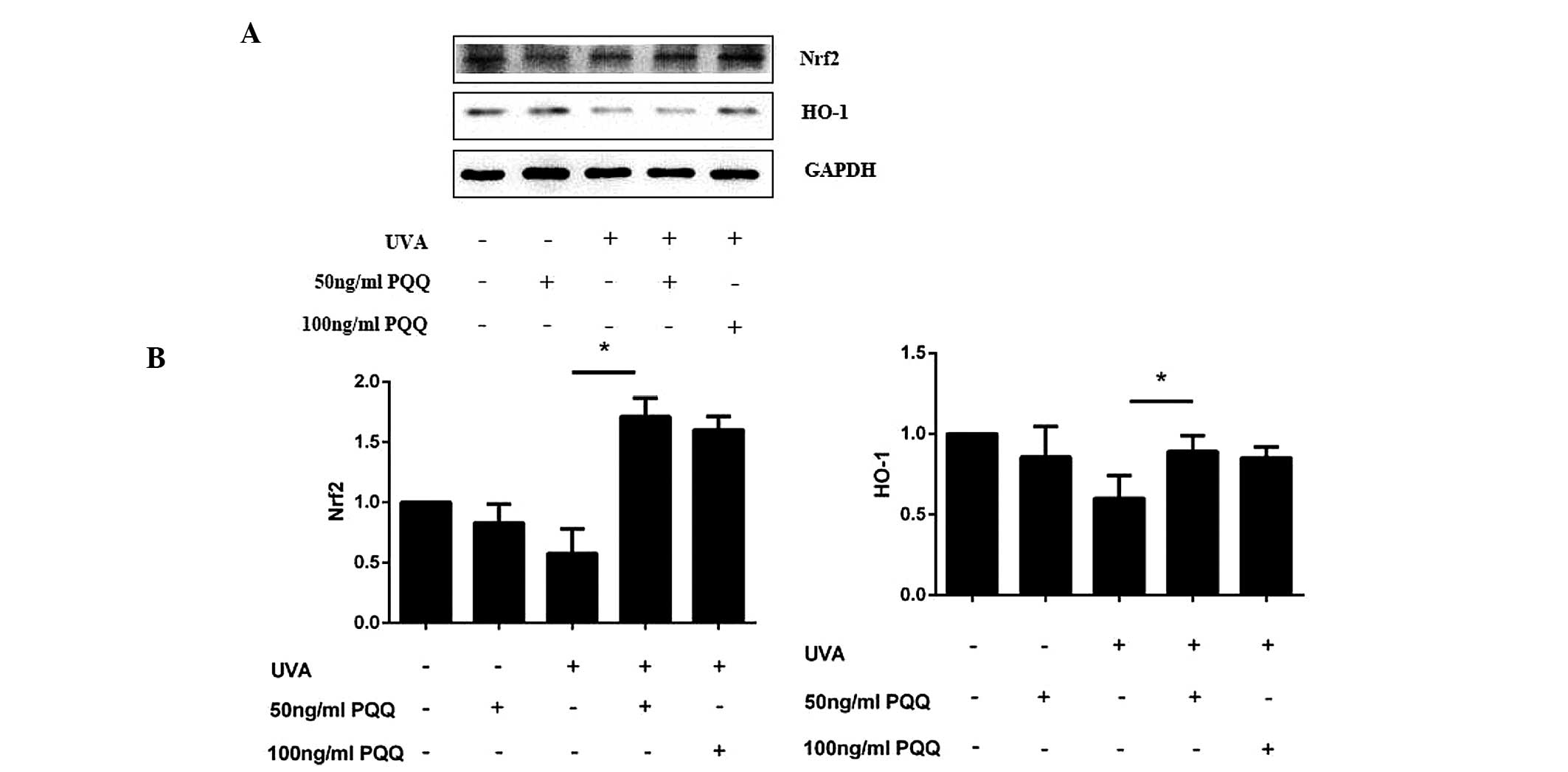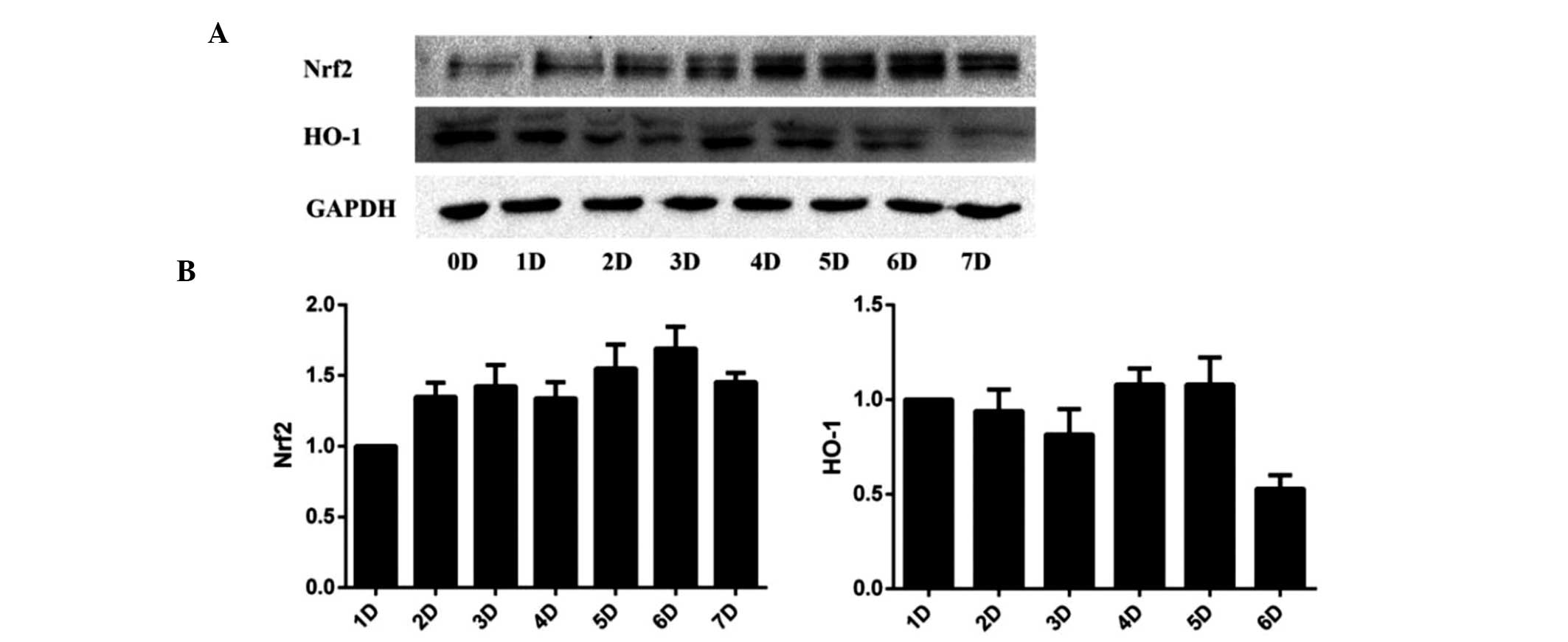|
1
|
Kohl E, Steinbauer J, Landthaler M and
Szeimies RM: Skin aging. J Eur Acad Dermatol. 25:873–884. 2011.
View Article : Google Scholar
|
|
2
|
He YY, Council SE, Feng L and Chignell CF:
UVA-induced cell cycle progression is mediated by a disintegrin and
metal-loprotease/epidermal growth factor receptor/AKT/Cyclin D1
pathways in keratinocytes. Cancer Res. 68:3752–3758. 2008.
View Article : Google Scholar : PubMed/NCBI
|
|
3
|
Krutmann J: Ultraviolet A
radiation-induced biological effects in human skin: relevance for
photo aging and photodermatosis. J Dermatol Sci. 23(Suppl 1):
S22–S26. 2000. View Article : Google Scholar
|
|
4
|
Salisbury SA, Forrest HS, Cruse WB and
Kennard O: A novel coenzyme from bacterial primary alcohol
dehydrogenases. Nature. 280:843–844. 1979. View Article : Google Scholar : PubMed/NCBI
|
|
5
|
Felton LM and Anthony C: Biochemistry:
role of PQQ as a mammalian enzyme cofactor? Nature. 433:E10–E12.
2005. View Article : Google Scholar : PubMed/NCBI
|
|
6
|
Matsushitak K, Toyama H, Yamada M, et al:
Quinoproteins: structure function and biotechnologies applications.
Appl Microboil Biot. 58:13–22. 2002. View Article : Google Scholar
|
|
7
|
Liu CL, Siesjö BK and Hu BR: Pathogenesis
of hippocampal neuronal death after hypoxia-ischemia changes during
brain development. Neuroscience. 127:113–123. 2004. View Article : Google Scholar : PubMed/NCBI
|
|
8
|
Dimri GP, Lee X, Basile G, et al: A
biomarker that identifies senescent human cells in culture and in
aging skin in vivo. Cell Biology. 92:9363–9367. 1995.
|
|
9
|
Ohwada K, Takeda H, Yamazaki M, Isogai H,
Nakano M, Shimomura M, Fukui K and Urano S: Pyrroloquinoline
quinone (PQQ) prevents cognitive deficit caused by oxidative stress
in rats. J Clin Biochem Nutr. 42:29–34. 2008. View Article : Google Scholar : PubMed/NCBI
|
|
10
|
Zhang Q, Shen M, Ding M, Shen D and Ding
F: The neuropro-tective action of pyrroloquinoline against
glutamate-induced apoptosis in hippocampal neurons is mediated
through the activation of PI3K/Akt pathway. Toxicol Appl Pharm.
252:62–72. 2011. View Article : Google Scholar
|
|
11
|
Kanfi Y, Naiman S, Amir G, et al: The
sirtuin SIRT6 regulates lifespan in male mice. Nature. 483:218–221.
2012. View Article : Google Scholar : PubMed/NCBI
|
|
12
|
Hekimi S and Guarente L: Genetics and the
specificity of the aging process. Science. 299:1351–1354. 2003.
View Article : Google Scholar : PubMed/NCBI
|
|
13
|
Howitz KT, Bitterman KJ, Cohen HY, et al:
Small molecule activators of sirtuins extend Saccharomyces
cerevisiae lifespan. Nature. 425:191–196. 2003. View Article : Google Scholar : PubMed/NCBI
|
|
14
|
Landry J, Sutton A, Tafrov ST, et al: The
silencing protein SIR2 and its homologs are NAD-dependent protein
deacetylases. Proc Natl Acad Sci USA. 97:5807–5811. 2000.
View Article : Google Scholar : PubMed/NCBI
|
|
15
|
Sugino T, Maruyama M, Tanno M, et al:
Protein deacetylase SIRT1 in the cytoplasm promotes nerve growth
factor-induced neurite outgrowth in PC12 cells. FEBS Lett.
584:2821–2826. 2010. View Article : Google Scholar : PubMed/NCBI
|
|
16
|
Hisahara S, Chiba S, Matsumoto H, et al:
Histone deacetylase SIRT1 modulates neuronal differentiation by its
nuclear translocation. Proc Natl Acad Sci USA. 105:15599–15604.
2008. View Article : Google Scholar : PubMed/NCBI
|
|
17
|
Michán S, Li Y, Chou MM, et al: SIRT1 is
essential for normal cognitive function and synaptic plasticity. J
Neurosci. 30:9695–9707. 2010. View Article : Google Scholar : PubMed/NCBI
|
|
18
|
Jin Q, Yan T, Ge X, Sun C, Shi X and Zhai
Q: Cytoplasm-localized SIRT1 enhances apoptosis. J Cell Physiol.
213:88–97. 2007. View Article : Google Scholar : PubMed/NCBI
|
|
19
|
Byles V, Chmilewski LK, Wang J, et al:
Aberrant cytoplasm localization and protein stability of SIRT1 is
regulated by PI3K/IGF-1R signaling in human cancer cells. Int J
Biol Sci. 6:599–612. 2010. View Article : Google Scholar : PubMed/NCBI
|
|
20
|
Herskovits AZ and Guarente L: Sirtuin
deacelylase in neurode-generative disease of aging. Cell Res.
23:746–758. 2013. View Article : Google Scholar : PubMed/NCBI
|
|
21
|
Herrmann G, Brenneisen P, Wlaschek M, et
al: Psoralen photo-activation promotes morphological and functional
changes in fibroblasts in vitro reminiscent of cellular senescence.
J Cell Sci. 111:759–767. 1998.
|
|
22
|
Brugè F, Venditti E, Tiano L, Littarru GP
and Damiani E: Reference gene validation for qPCR on normoxia- and
hypoxia-cultured human dermal fibroblasts exposed to UVA: is
β-actin a reliable normalize for photoaging studies? J Biotechnol.
156:153–162. 2011. View Article : Google Scholar
|
|
23
|
Kawahara TL, Michishita E, Adler AS, et
al: SIRT6 links histone H3 lysine 9 deacetylation and organismal
life span. Cell. 136:62–74. 2008. View Article : Google Scholar
|
|
24
|
Herrmann G, Wlaschek M, Lange TS, et al:
UVA irradiation stimulates the synthesis of various
matrix-metalloproteinases (MMPs) in cultured human fibroblasts. Exp
Dermatol. 2:92–97. 1993. View Article : Google Scholar : PubMed/NCBI
|
|
25
|
Masek T, Vopalensky V, Suchomelova P and
Pospisek M: Denaturing RNA electrophoresis in TAE agrose gels. Anal
Biochem. 336:46–50. 2005. View Article : Google Scholar
|
|
26
|
Vandesompele J, De Preter K, Pattyn F, et
al: Accurate normalization of real-time quantitative RT-PCR data by
geometric average of multiple internal control genes. Genome Biol.
3:RESEARCH00342002. View Article : Google Scholar
|
|
27
|
Li H, Wu S, Shi N, Lian S and Lin W:
Nrf2/HO-1 pathway activation by manganese is associated with
reactive oxygen species and ubiquitin-proteasome pathway, not MAPKs
signaling. J Appl Toxicol. 31:690–697. 2011. View Article : Google Scholar : PubMed/NCBI
|
|
28
|
Kimura K, Takada M, Ishii T, et al:
Pyrroloquinoline quinine stimulates epithelial cell proliferation
by activating epidermal growth factor receptor through redox
cycling. Free Radical Bio Med. 53:1239–1251. 2012. View Article : Google Scholar
|
|
29
|
Zhang Q, Ding M, Cao Z, et al:
Pyrroloquinoline quinine protects rat brain cortex against acute
glutamate-induced neurotoxicity. Neutovhrm Res. 38:1661–1671.
2013.
|
|
30
|
Li HH, He B, Peng H and Liu SQ: Effects of
pyrroloquinoline quinine on proliferation and expression of c-fos,
c-jun, CREB and PCNA in cultured Schwann cells. Zhonghua Zheng Xing
Wai Ke Za Zhi. 27:298–303. 2011.In Chinese. PubMed/NCBI
|
|
31
|
Blander G and Guarente L: The Sir family
of protein deaceylases. Annu Rev Biochem. 73:417–435. 2004.
View Article : Google Scholar
|
|
32
|
Lin SJ, Defossez PA and Guarente L:
Requirement of NAD and SIR2 for life-span extension by calorie
restriction in Sacharomyces cerevisiae. Science. 289:2126–2128.
2000. View Article : Google Scholar : PubMed/NCBI
|
|
33
|
Frye RA: Characterization of five human
cDNAs with homology to the yeast SIR2 gene: Sir2-like proteins
(sirtuins) metabolize NAD and may have protein
ADP-ribosyltransferase activity. Biochem Biophys Res Commun.
260:273–279. 1999. View Article : Google Scholar : PubMed/NCBI
|




















